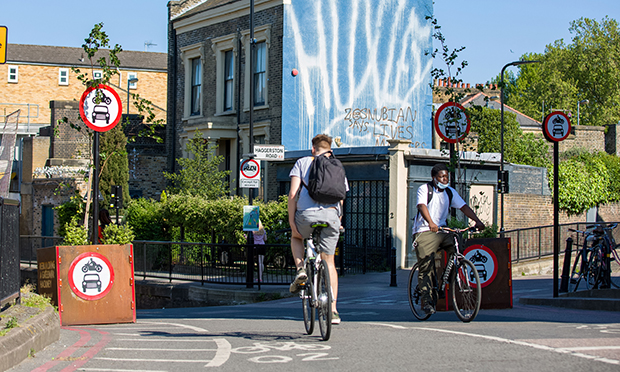Council drives forward with plans to cut traffic and ‘humanise streets’

Middleton Road LTN. Photograph: Hackney Council
Hackney Council has said it is committed to “seriously” scaling back motor traffic over the next decade in a bid to “humanise streets”.
On Monday (7 April), the skills, economy and growth scrutiny committee heard from council officers about how it plans to engage residents about Hackney’s transport strategy for the next ten years.
Led by the borough’s transport chief, Cllr Sarah Young, the Town Hall preparing two public consultations over its approach to making main roads safer and creating a “harmonious” transport system.
The council’s evidence base for the strategy states: “Above all, we will seriously pursue motor traffic reduction to humanise our streets seeking to build on the rapid expansion of low traffic neighbourhoods (LTNs) and school streets”.
Drawing on a raft of statistics about travel in the borough, transport officers highlighted the persistent challenge of unhealthy air pollution and stubborn carbon emissions from the transport network.
Although LTNs now cover 70 per cent of eligible roads in the borough, the report states that main roads remain “dominated” by motor traffic, of which nearly half is created by vehicles passing through Hackney.
While the council has previously said it is considering more of these low traffic zones in Dalston, Chatsworth Road and Hoxton East, Cllr Penny Wrout (Victoria, Independent Socialist) raised concerns that officers would carry a “burden of raw feeling” around how they were first introduced.
While praising the “impressive array of engagement approaches” put forward, she worried that “people will fill out the first consultation and then think, ‘well, I’ve done that – why would I do another one?'”
“Part of the problem with the residual ill feeling from LTN consultations is that people didn’t understand exactly what they were being consulted on,” she said.
“We could do better at explaining that and trying to give credibility to our consultations because we have some work to make up here at the moment.”
In 2021, community company HHRC Ltd attempted to bring the council’s decision to rollout LTNs in the borough to judicial review, but this was dismissed.
Later that year, the High Court threw out the company’s legal challenge which alleged there had not been proper consultation on the scheme.
LTNs have also been opposed by the Conservative opposition group, whose mayoral candidate previously pledged to “rip out” his local LTN if he was elected.
Cllr Young said the way low traffic zones were introduced was influenced by “the nature of the funding and the decision-making”.
This meant it was “absolutely key that we are keeping [the engagement] very open.”
The council plans to undertake two consultations on its priorities for the next ten years, and these are expected to begin towards the autumn.
Between now and July, the Town Hall states it will engage stakeholders like TfL, the London Cycling campaign, Travelwatch and London Taxi Drivers Association.
It will also host a series of focus group, including with young people, neighbourhood panels and forums, schools, disabled residents and religious groups.
An open public survey seeking locals’ views on transport in Hackney will run until 9 June.
